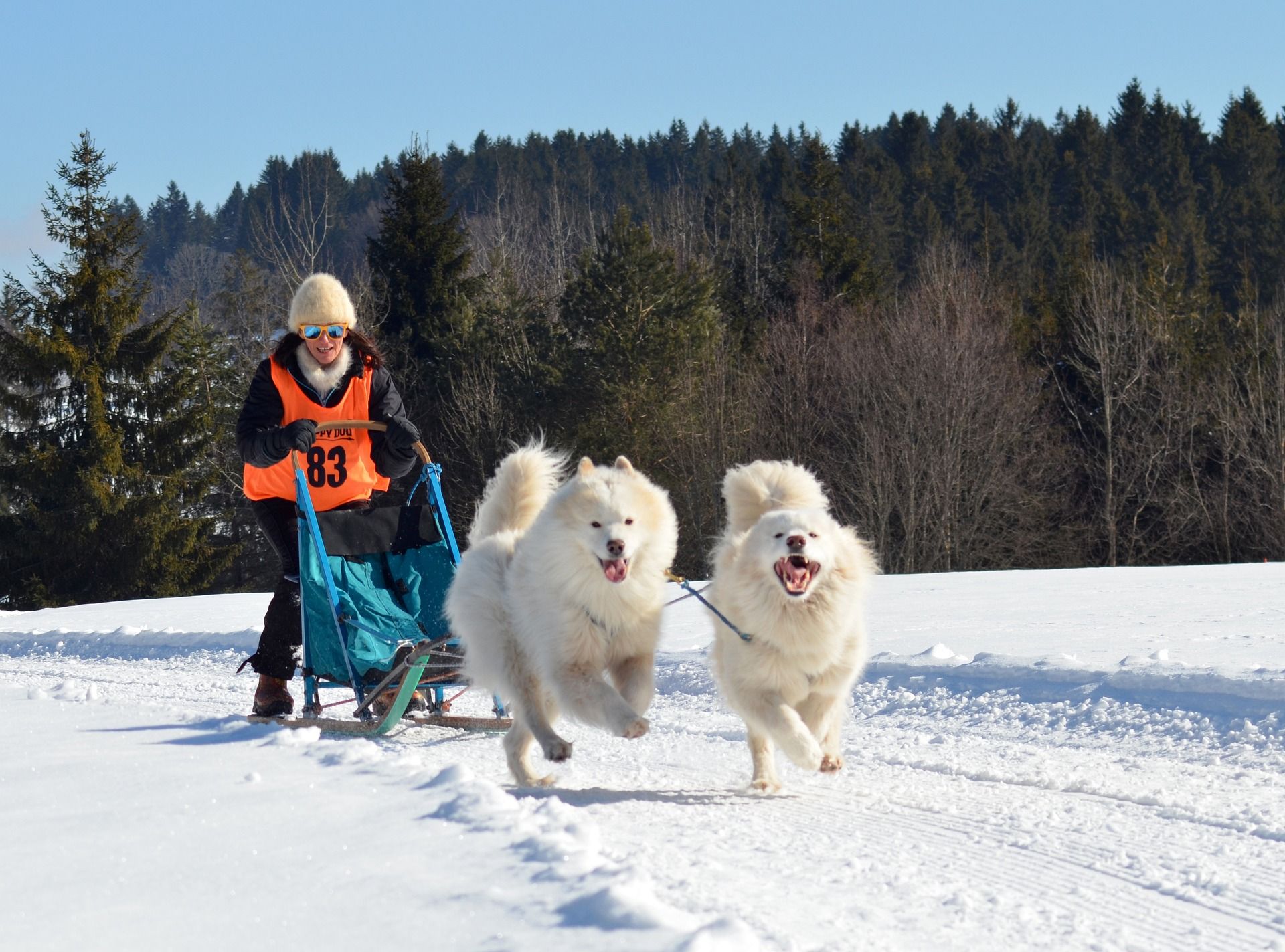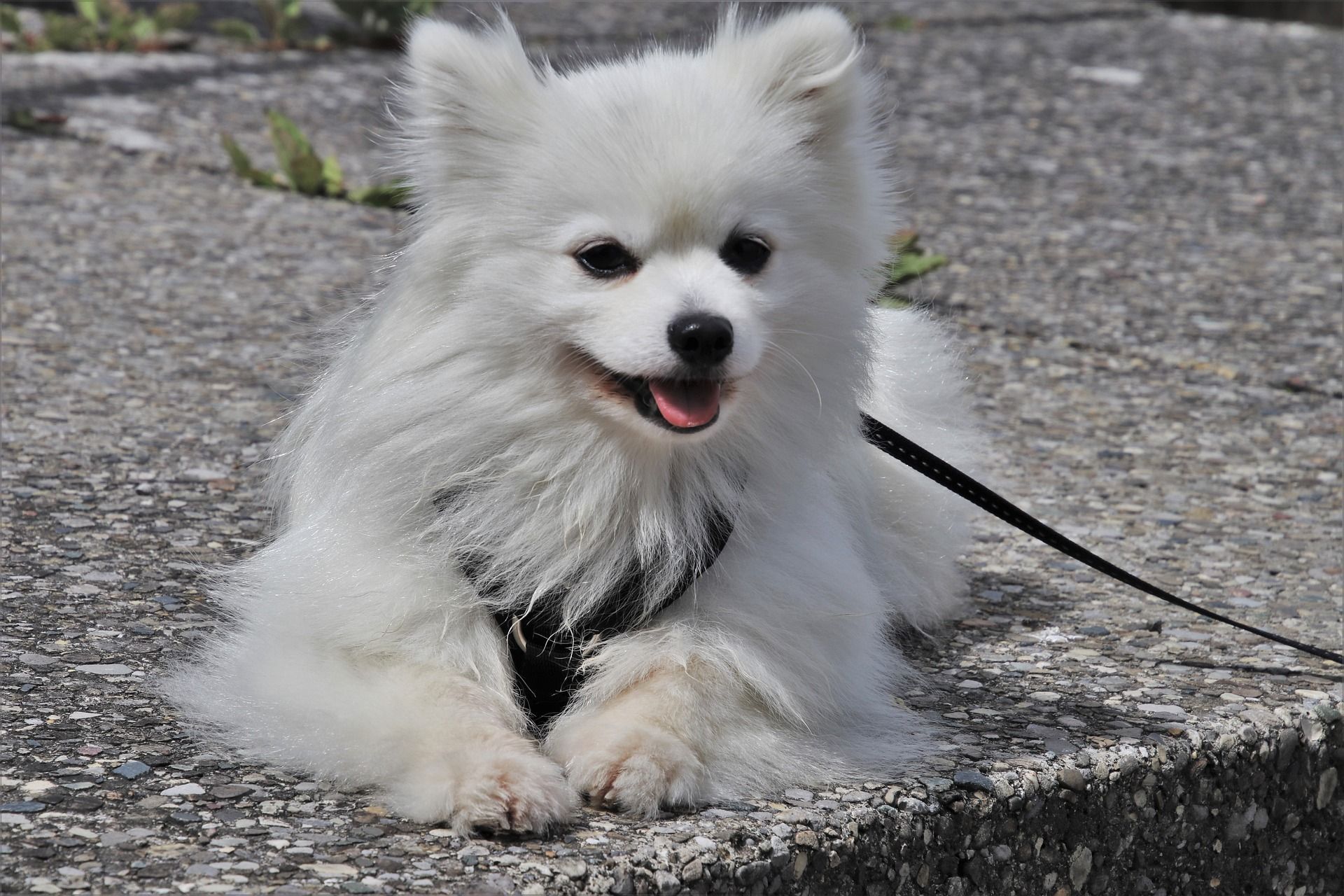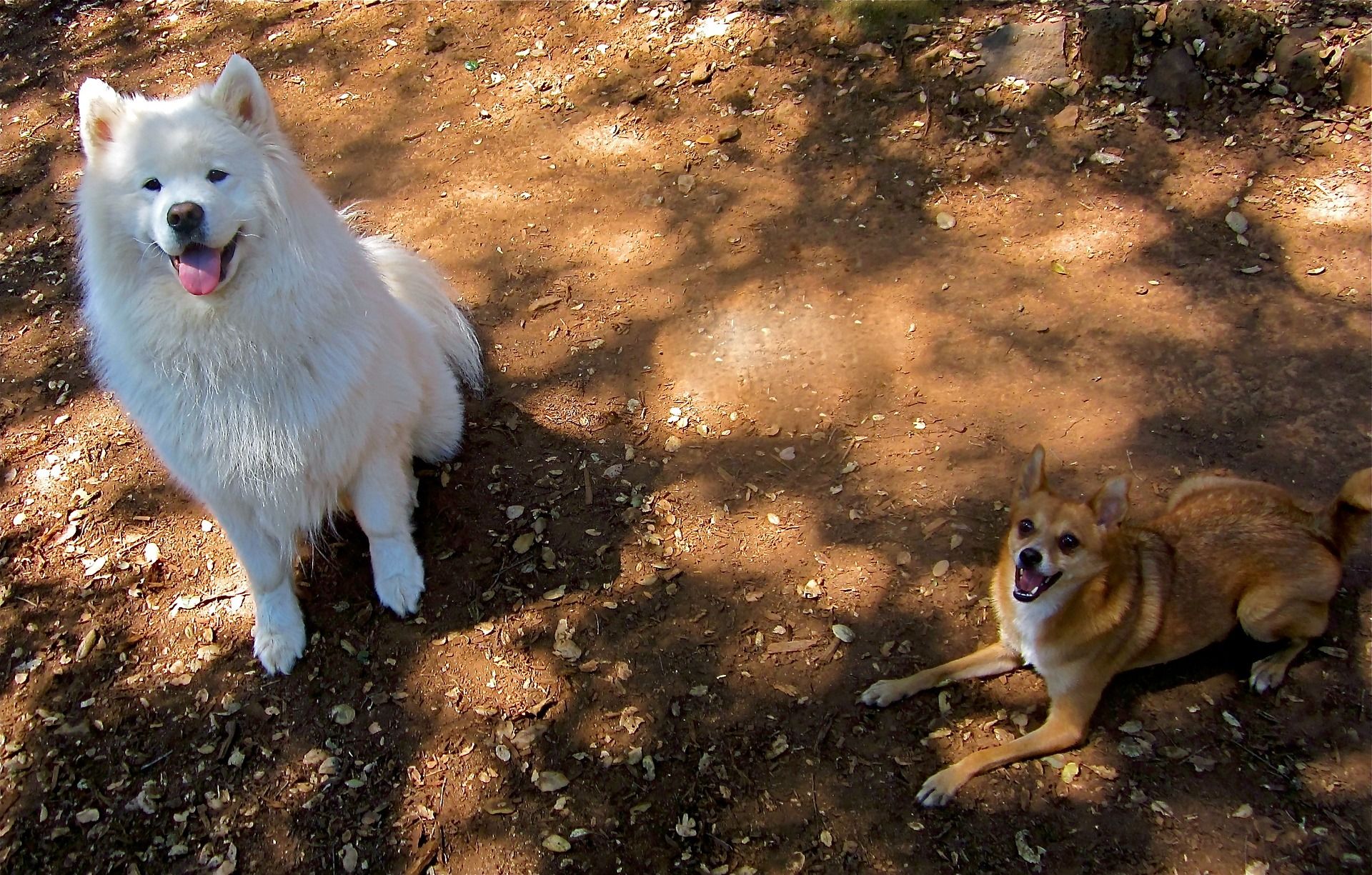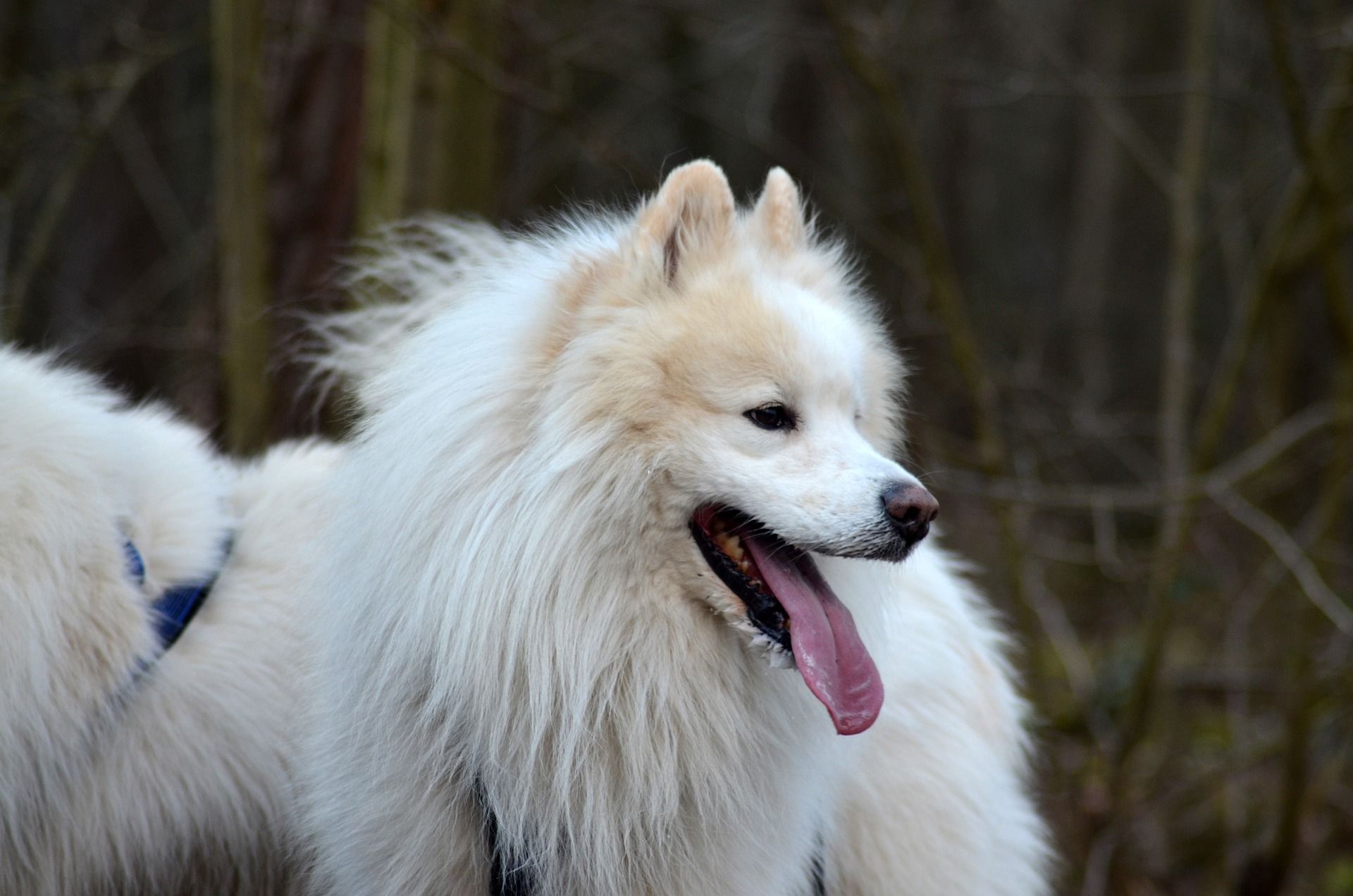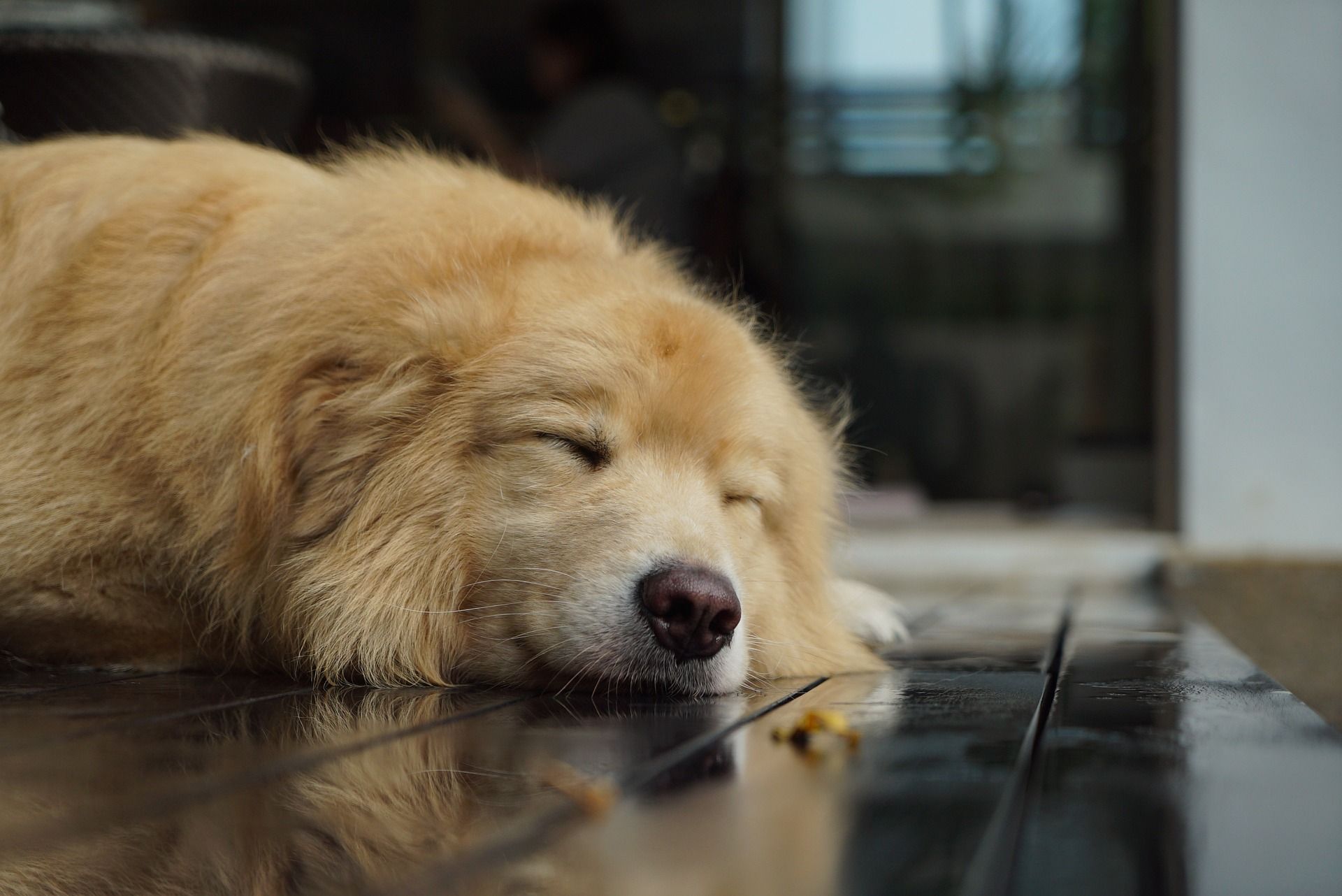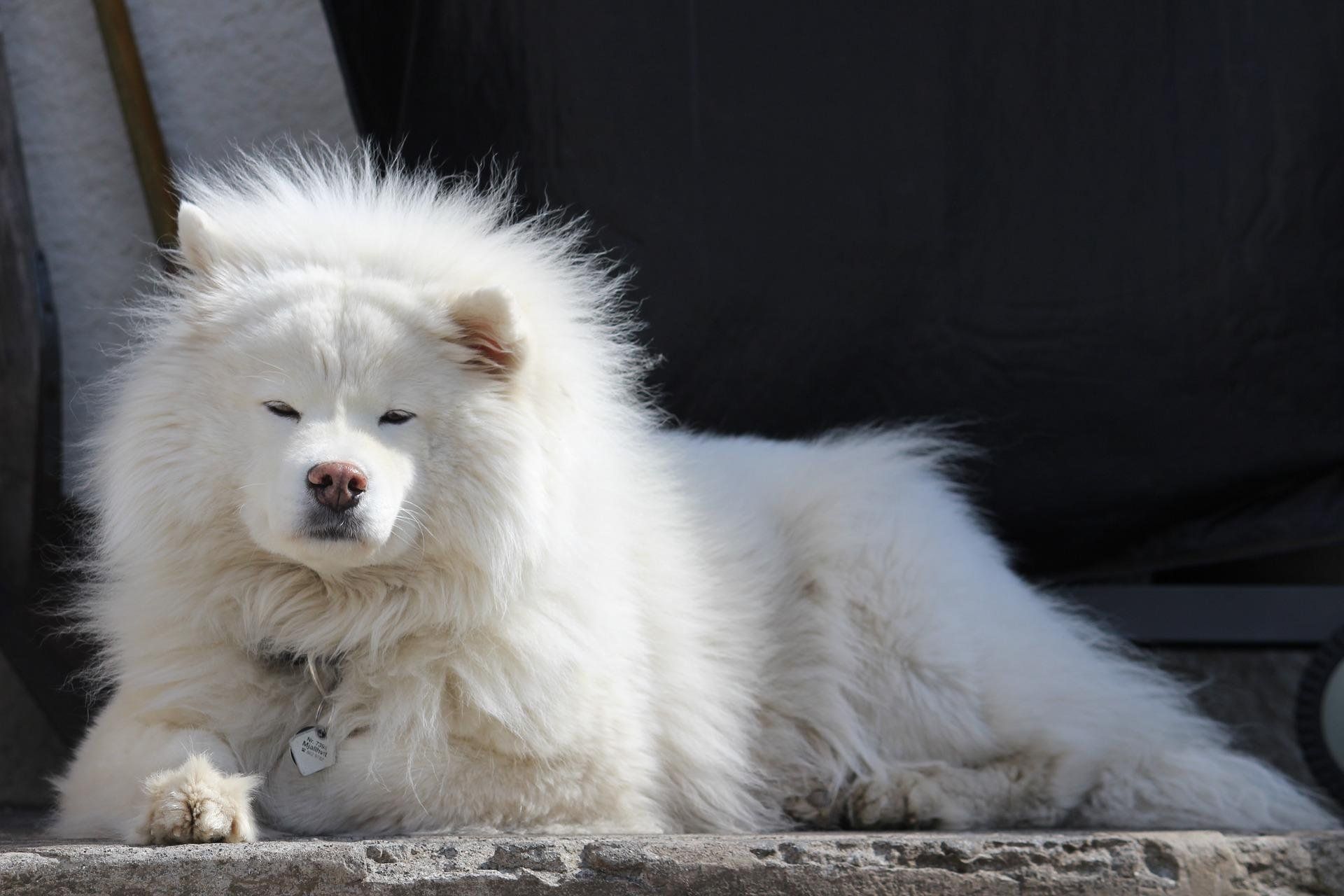This is a detailed question and answer guide on samoyed sheddding where we answer everything from seasons, coat care, variations, allergens, to concerns
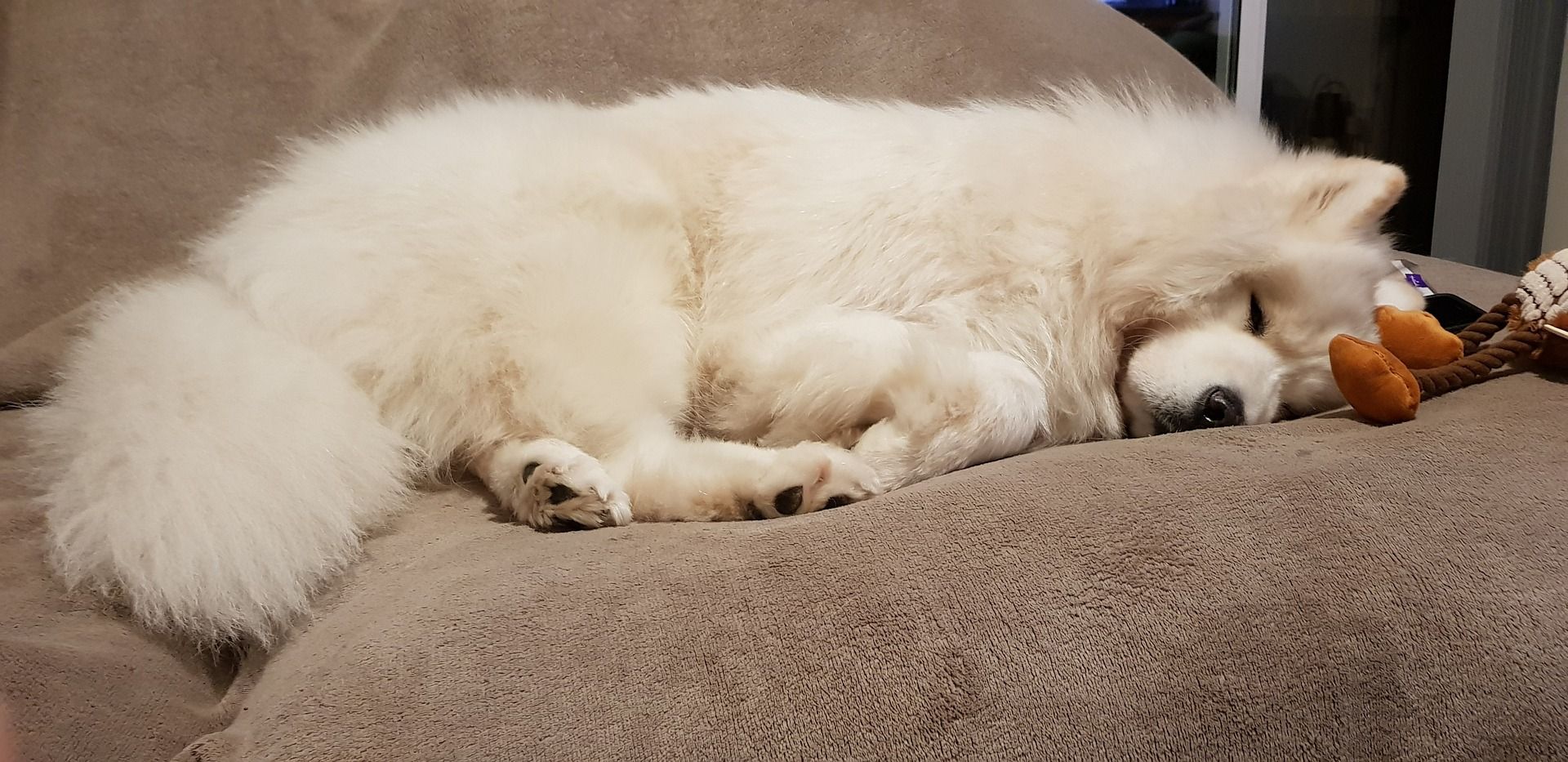
Samoyeds have distinctive coat characteristics that are essential to their breed and contribute to their appearance and functionality in cold climates. A common concern for this breed is shedding. This article answers common questions related to Samoyed shedding.
Table of Contents
Do samoyeds shed a lot?
Yes, Samoyeds are known to shed a lot, and their shedding is considered heavy, especially during certain times of the year.
Understanding the shedding patterns and coat care requirements of Samoyeds is essential for owners of this breed.
Samoyed Coat Characteristics
Samoyeds have distinctive coat characteristics that are essential to their breed and contribute to their appearance and functionality in cold climates.
Here are key features of the Samoyed coat:
- Double coat: Samoyeds possess a double coat, which consists of two distinct layers: an insulating undercoat and a longer, protective outer coat. This double coat provides insulation against both cold and warm weather.
- Undercoat: The undercoat is soft, dense, and close to the skin. It serves as an effective insulator, keeping the dog warm in cold temperatures. The undercoat is shed seasonally, typically during spring and fall.
- Outer coat: The outer coat is composed of longer, coarse guard hairs that protect the Samoyed from the elements. This outer layer helps repel water and prevent the penetration of snow.
- Color: Samoyeds are known for their distinctive white or cream-colored coat. The breed standard generally prefers pure white, but slight variations in color, such as biscuit or light yellow, are also accepted.
- Ruff and mane: One of the striking features of the Samoyed is the dense ruff of fur around the neck and shoulders, often referred to as a “mane.” This ruff serves both functional and aesthetic purposes, providing additional insulation and enhancing their appearance.
- Feathering: Samoyeds exhibit feathering, which refers to longer hair on the tail, legs, and sometimes on the ears. The feathering adds to the breed’s overall elegance.
- Tail: The Samoyed’s tail is plume-like and carried over the back. The tail’s hair is longer and more profuse, creating a distinctive appearance.
- Weather-resistant: The Samoyed’s coat is weather-resistant, providing protection against harsh conditions. The dense double coat helps regulate body temperature in various climates.
- Shedding: Samoyeds are known for shedding, particularly during shedding seasons. Regular grooming is required to manage shedding and keep the coat healthy.
- Matting: Due to their thick coat, Samoyeds are prone to matting. Regular brushing and grooming help prevent mats and tangles, ensuring the coat remains in good condition.
- Adaptation to arctic conditions: Samoyeds were originally bred by the nomadic Samoyedic people in Siberia to work in harsh Arctic conditions. Their coat served as insulation against extreme cold and protected them during sledding and herding activities.
Appreciating these coat characteristics are crucial for Samoyed owners, as proper grooming and care are essential to maintaining the health and beauty of the coat. For instance, regular brushing, especially during shedding seasons, is key to preventing matting and ensuring the coat’s overall well-being.
Shedding Seasons
Samoyeds typically undergo shedding during specific seasons, and understanding these shedding patterns is essential for proper coat care. The shedding seasons for Samoyeds are generally associated with changes in temperature and daylight.
The shedding seasons are sometimes referred to as “blowing coat” periods because the undercoat sheds more profusely during these times.
The shedding is a natural and necessary process for Samoyeds to maintain a healthy coat and adapt to seasonal changes.
What are the shedding seasons for Samoyeds?
The two primary shedding seasons for Samoyeds are:
Season #1 — Spring Shedding
During the spring, typically in the months of March to May, Samoyeds shed their winter undercoat. The shedding process helps them adapt to the warming temperatures by getting rid of the thicker, insulating undercoat that kept them warm during the colder winter months.
Season #2 — Fall Shedding
In the fall, usually in the months of September to November, Samoyeds shed their summer coat. The shedding during this period allows them to grow a denser undercoat that will provide insulation during the upcoming winter. This shedding ensures they are well-prepared for colder weather.
These shedding seasons are natural and essential for the health and well-being of Samoyeds. The breed’s double coat undergoes a renewal process, and the shedding helps them regulate their body temperature in different seasons.
It’s worth noting that the intensity and duration of shedding may vary among individual dogs.
How often do Samoyeds shed throughout the year?
Samoyeds typically shed throughout the year, but as discussed above, there are specific shedding seasons during which the shedding is more pronounced—primary shedding seasons i.e. spring and fall shedding seasons.
While these are the main shedding seasons, Samoyeds may also experience some level of shedding throughout the year.
During shedding seasons, Samoyed owners often notice an increase in loose fur, and regular grooming becomes crucial to manage shedding effectively. Consistent brushing helps remove loose hair, prevents matting, and promotes a healthy coat.
Managing Shedding
Managing Samoyed shedding is an important aspect of caring for this breed, known for its thick double coat. Regular grooming and a consistent care routine can help keep shedding under control and maintain the health of the coat.
Here are some tips for managing Samoyed shedding:
- Regular brushing: Brush your Samoyed’s coat regularly, ideally several times a week, to remove loose fur and prevent matting. During shedding seasons, daily brushing may be necessary to manage the increased shedding.
- Use the right tools: Invest in proper grooming tools, such as an undercoat rake or slicker brush, to effectively remove loose hair from the dense undercoat.
- Start grooming early: Begin grooming your Samoyed from a young age to get them accustomed to the process. This helps establish a positive association with grooming.
- Bathe as needed: Bathe your Samoyed every few months or as needed to keep the coat clean. Use a dog-friendly shampoo that won’t strip natural oils from the coat.
- Blow coat periods: During shedding seasons (spring and fall), often referred to as “blow coat” periods, increase the frequency of grooming to manage the heavier shedding.
- Check for mats: Regularly check for mats, especially in areas with longer hair, and gently remove them to prevent discomfort and skin issues.
- Address undercoat density: Pay special attention to the dense undercoat, which is shed more heavily. Use an undercoat rake to reach through the topcoat and remove loose undercoat fur.
- Professional grooming: Consider professional grooming services, especially if you find it challenging to manage your Samoyed’s coat on your own. Professional groomers are experienced in handling double-coated breeds.
- Provide a balanced diet: Ensure your Samoyed is on a balanced and nutritious diet. A healthy diet contributes to overall coat health and may reduce excessive shedding.
- Hydration: Make sure your Samoyed stays hydrated. Proper hydration supports a healthy coat.
- Supplements: Consult with your veterinarian about supplements, such as omega-3 fatty acids, that may promote coat health and reduce shedding.
- Manage allergens: Regularly vacuum and clean your living spaces to manage loose fur and reduce allergens. Use lint rollers on clothing if necessary.
- Positive reinforcement: Use positive reinforcement during grooming sessions. Reward your Samoyed with treats, praise, or play to make the experience enjoyable.
- Professional grooming during shedding seasons: If the shedding becomes particularly heavy during shedding seasons, consider professional grooming services to manage the excess fur effectively.
By incorporating these practices into your Samoyed’s care routine, you can effectively manage shedding, maintain a healthy coat, and ensure your Samoyed remains comfortable and happy.
Regular grooming not only controls shedding but also provides an opportunity to check for any skin issues, ticks, or other health concerns.
What are the best grooming tools for managing Samoyed shedding?
Grooming tools play a crucial role in managing Samoyed shedding, given their dense double coat.
Here are some of the best grooming tools recommended for effectively managing Samoyed shedding:
- Slicker brush: A slicker brush is a must-have for Samoyeds. It has fine, short wires close together, making it ideal for removing loose hair and preventing matting. Use it to brush through both the topcoat and undercoat.
- Undercoat rake: An undercoat rake is specifically designed to reach through the topcoat and remove loose undercoat fur. This tool helps thin out the dense undercoat during shedding seasons.
- Comb with rotating teeth: A comb with rotating teeth is useful for detangling and removing loose hair. The rotating teeth help prevent discomfort and make the grooming process more comfortable for your Samoyed.
- Dematting tool: A dematting tool can be handy for gently removing mats and tangles from the longer hair, especially in areas prone to matting.
- Grooming gloves: Grooming gloves with rubber or silicone tips can be effective for removing loose fur. The gloves allow you to pet your Samoyed while simultaneously capturing loose hair.
- Bristle brush: A bristle brush with soft, natural bristles can be used to smooth the topcoat and distribute natural oils, promoting a healthy and shiny coat.
- Furminator or deshedding tool: A deshedding tool, such as the Furminator, is designed to reduce shedding by removing loose hair from the undercoat without cutting or damaging the topcoat.
- Mat splitter: For more stubborn mats, a mat splitter can be used to gently cut through the mat without harming the surrounding fur.
- Grooming scissors: A pair of grooming scissors with rounded tips can be useful for trimming and maintaining the hair around the paws, ears, and other sensitive areas.
- Grooming table with a non-slip surface: A grooming table provides a stable surface for grooming sessions and makes it easier to reach different parts of your Samoyed’s body. Ensure the surface is non-slip to prevent accidents.
- Stainless steel comb: A stainless steel comb with both wide and narrow teeth can be used for a final pass to ensure all loose hair has been removed.
- Spray conditioner or detangler: A spray conditioner or detangler can be applied to the coat before grooming to make it easier to brush through and reduce static, preventing matting.
When using these grooming tools, it’s important to be gentle and patient, especially around sensitive areas. Regular grooming sessions not only manage shedding but also promote bonding between you and your Samoyed.
If you’re unsure about the best grooming tools or techniques for your specific Samoyed, consider consulting a professional groomer for guidance.
Are there specific grooming techniques that help reduce shedding?
Yes, specific grooming techniques can help reduce shedding in Samoyeds.
While it’s important to note that shedding is a natural process for this breed, regular grooming practices can minimize loose fur and prevent matting.
Here are grooming techniques to help reduce shedding in Samoyeds:
- Regular brushing: Brush your Samoyed’s coat regularly, ideally several times a week. Daily brushing may be necessary during shedding seasons. This helps remove loose fur before it falls out and reduces the amount of hair around the house.
- Use an undercoat rake: An undercoat rake is a specialized tool designed to reach through the topcoat and remove loose undercoat fur effectively. Use it to thin out the dense undercoat during shedding seasons.
- Bristle brush for topcoat: Use a bristle brush with soft, natural bristles to smooth and distribute natural oils in the topcoat. This can help keep the coat healthy and reduce shedding.
- Furminator or deshedding tool: Consider using a deshedding tool, such as the Furminator, to remove loose hair from the undercoat without cutting or damaging the topcoat. This tool can be particularly effective during shedding seasons.
- Check for mats: Regularly check for mats, especially in areas with longer hair. Mats can trap loose fur and contribute to shedding. Gently remove any mats to prevent discomfort.
- Rotate grooming tools: Use a combination of grooming tools, including slicker brushes, undercoat rakes, and deshedding tools, to ensure you are effectively addressing both the topcoat and undercoat.
- Bathe as needed: Bathe your Samoyed every few months or as needed using a dog-friendly shampoo. Bathing helps keep the coat clean and can reduce shedding by removing loose hair.
- Apply conditioner: Use a conditioner after bathing to keep the coat soft and more resistant to tangling. A well-moisturized coat is less likely to shed excessively.
- Regular grooming sessions: Schedule regular grooming sessions to stay ahead of shedding. This is especially important during shedding seasons when loose fur is more prevalent.
- Trimming around paws and ears: Keep the hair around the paws and ears trimmed. This not only enhances your Samoyed’s appearance but also reduces the risk of matting in these areas.
- Grooming gloves: Grooming gloves with rubber or silicone tips can be effective for removing loose fur while petting your Samoyed. This can be a gentle way to manage shedding between formal grooming sessions.
- Use positive reinforcement: Use positive reinforcement during grooming sessions to make the experience enjoyable for your Samoyed. Reward them with treats, praise, or play.
Remember that while these grooming techniques can help manage shedding, some shedding is normal for Samoyeds, especially during shedding seasons. If you have concerns about excessive shedding or notice changes in your Samoyed’s coat, consult with a veterinarian to rule out any underlying health issues.
Coat Care
Samoyed coat care is essential to maintain the health, appearance, and comfort of this breed’s distinctive double coat.
Here are some guidelines for effective Samoyed coat care:
- Regular brushing: Brush your Samoyed’s coat at least several times a week, if not daily, to remove loose fur, prevent matting, and distribute natural oils. Use a slicker brush, undercoat rake, and other appropriate grooming tools.
- Start grooming early: Begin grooming your Samoyed from a young age to get them accustomed to the process. This helps establish a positive association with grooming and makes it easier for both you and your dog.
- Focus on the undercoat: Pay special attention to the dense undercoat, especially during shedding seasons. Use an undercoat rake to reach through the topcoat and remove loose undercoat fur.
- Check for mats and tangles: Regularly check for mats and tangles, especially in areas with longer hair, such as behind the ears and on the legs. Gently remove any mats using appropriate grooming tools.
- Trimming around paws and ears: Keep the hair around the paws and ears trimmed to prevent matting and maintain cleanliness. Use grooming scissors with rounded tips for sensitive areas.
- Bathe as needed: Bathe your Samoyed every few months or as needed, using a dog-friendly shampoo. Be sure to rinse thoroughly to remove all shampoo residue.
- Use a conditioner: Apply a dog conditioner after bathing to keep the coat soft and manageable. Conditioner helps reduce tangles and promotes a healthy, shiny coat.
- Avoid overbathing: Avoid overbathing, as excessive bathing can strip the coat of natural oils, leading to dryness. Samoyeds generally do not have a strong odor, so bathing every few months is usually sufficient.
- Grooming table with non-slip surface: Consider using a grooming table with a non-slip surface for stability during grooming sessions. This makes it easier to reach different parts of your Samoyed’s body.
- Professional grooming: If you find grooming challenging or if your Samoyed’s coat requires extra care, consider professional grooming services. Professional groomers are experienced in handling double-coated breeds.
- Monitor for skin issues: Regularly check your Samoyed’s skin for any signs of redness, irritation, lumps, or bumps. If you notice anything unusual, consult with your veterinarian.
- Provide a balanced diet: Ensure your Samoyed is on a balanced and nutritious diet. Proper nutrition contributes to overall coat health.
- Hydration: Make sure your Samoyed stays hydrated, as proper hydration supports a healthy coat.
Consistent and attentive coat care is crucial for Samoyeds to ensure their double coat remains healthy and functional. Regular grooming not only manages shedding but also provides an opportunity to check for any skin issues or abnormalities.
Always use dog-friendly grooming products, be gentle during grooming sessions, and create a positive experience for your Samoyed.
What is the importance of regular brushing in Samoyed coat care?
Regular brushing is crucial in Samoyed coat care due to the unique characteristics of their double coat.
The following highlight the significance of regular brushing for Samoyeds:
- Removal of loose fur: Samoyeds are known for shedding, especially during shedding seasons. Regular brushing helps remove loose fur from both the topcoat and dense undercoat, preventing excessive hair from accumulating around the house.
- Prevention of matting and tangles: Samoyed coats can be prone to matting and tangling, especially in areas with longer hair. Regular brushing prevents mats and tangles by keeping the coat free of loose fur and preventing hair from interweaving.
- Distribution of natural oils: Brushing helps distribute the natural oils produced by the skin throughout the coat. This contributes to a healthy, shiny, and well-moisturized coat.
- Stimulation of skin and hair follicles: Brushing stimulates the skin and hair follicles, promoting blood circulation. This stimulation is beneficial for skin health and can contribute to a lustrous coat.
- Monitoring skin and coat health: Regular brushing allows owners to monitor the overall health of the skin and coat. It provides an opportunity to detect any abnormalities, such as lumps, bumps, redness, or signs of skin irritation, at an early stage.
- Bonding and positive interaction: Brushing sessions provide an opportunity for bonding between the owner and the Samoyed. It can be a positive and enjoyable experience for the dog, strengthening the human-animal bond.
- Prevention of overheating: During warmer months, regular brushing helps thin out the undercoat, preventing the Samoyed from overheating. This is particularly important for a breed originally adapted to cold climates.
- Reduced shedding impact: Regular brushing, especially during shedding seasons, reduces the impact of shedding on the living environment. It minimizes the amount of loose fur that would otherwise end up on furniture, clothing, and floors.
- Prevention of skin irritation: Removing loose fur through brushing prevents it from becoming trapped in the coat, which can lead to skin irritation and discomfort for the Samoyed.
- Maintenance of aesthetic appearance: Regular brushing contributes to the maintenance of the Samoyed’s aesthetic appearance. It helps keep the distinctive double coat looking clean, fluffy, and well-groomed.
Regular brushing is a fundamental aspect of Samoyed coat care, offering numerous benefits for both the dog’s health and the overall well-being of the coat. It is a proactive measure that helps prevent common issues associated with the breed’s coat, ensures a clean and healthy appearance, and strengthens the bond between the owner and their Samoyed.
How often should Samoyeds be bathed to help with shedding?
Samoyeds generally do not require frequent bathing, and overbathing can strip their coat of natural oils, leading to dryness.
The frequency of bathing can vary based on factors such as the individual dog’s lifestyle, activity level, and exposure to dirt or odors.
However, as a general guideline:
- Bathing frequency: Bathe your Samoyed every few months or as needed. For most Samoyeds, a bath every 2 to 3 months is typically sufficient.
- Consider specific needs: Assess your Samoyed’s specific needs. If they spend a lot of time outdoors, get particularly dirty, or develop an odor, you may need to bathe them more frequently.
- Use dog-friendly shampoo: When bathing your Samoyed, use a high-quality dog-friendly shampoo. Avoid using human shampoos, as they may not be suitable for a dog’s skin and coat.
- Conditioning after bathing: Consider using a dog conditioner after bathing. Conditioning helps keep the coat soft and manageable, reducing tangles and potential shedding.
- Proper rinsing: Ensure thorough rinsing to remove all shampoo and conditioner residues. Residual products can lead to skin irritation and impact the texture of the coat.
- Dry the coat: After bathing, make sure to dry your Samoyed’s coat thoroughly. Use a towel or a low-heat setting on a dog-friendly hairdryer. A fully dry coat prevents matting and ensures comfort for the dog.
While bathing can contribute to managing shedding by removing loose hair and promoting a healthy coat, it’s essential to focus on regular brushing as the primary method for shedding control in Samoyeds. Brushing helps remove loose fur, prevents matting, and distributes natural oils throughout the coat.
Excessive bathing may lead to the removal of these natural oils, which can impact the overall health of the double coat.
Shedding Variation
Shedding variation is how much the intensity of shedding can vary among individual dogs.
Do all Samoyeds shed the same amount, or does it vary between individuals?
Samoyeds, like many double-coated breeds, experience shedding, and the intensity of shedding can vary among individual dogs.
Several factors contribute to shedding variation in Samoyeds:
- Genetics: The genetics of each individual Samoyed play a significant role in determining their shedding patterns. Some dogs may naturally shed more than others due to their genetic predisposition.
- Age: The age of a Samoyed can influence shedding. Puppies may shed less than adult dogs, and senior dogs might experience changes in their coat as they age
- Health and nutrition: The overall health and nutritional status of a Samoyed can impact shedding. Dogs with poor nutrition or underlying health issues may experience more significant shedding.
- Environmental factors: The environment in which a Samoyed lives can affect shedding. Changes in climate, temperature, and exposure to natural light can influence the dog’s coat cycles.
- Hormonal changes: Hormonal changes, such as those associated with the dog’s reproductive cycle, pregnancy, or spaying/neutering, can impact shedding.
- Seasonal changes: Seasonal variations have a notable impact on shedding in Samoyeds. They typically shed more during spring and fall as they adapt to temperature changes.
- Grooming practices: The frequency and effectiveness of grooming practices can influence shedding. Regular brushing helps remove loose fur and manage shedding. Inconsistency in grooming may result in more noticeable shedding.
- Indoor vs. outdoor living: Dogs that primarily live indoors may have a more consistent shedding pattern compared to those that spend more time outdoors. Outdoor dogs may be exposed to different environmental factors affecting their coat.
- Bathing habits: Bathing frequency and the use of appropriate grooming products can impact shedding. Overbathing may lead to dry skin and increased shedding, while proper bathing can help manage shedding.
- Stress levels: Stress and anxiety can affect a Samoyed’s overall health, including their coat condition. Dogs under stress may exhibit changes in shedding patterns.
- Coat color: While the breed standard prefers a pure white coat, slight color variations exist in some Samoyeds. Coat color may have a subtle influence on shedding.
It’s essential for Samoyed owners to be observant of their dog’s individual shedding patterns and adapt grooming practices accordingly.
Reducing Allergens
While no dog breed is completely hypoallergenic, Samoyeds are known to produce fewer allergens compared to some other breeds.
Here are some factors that may contribute to Samoyeds being perceived as less allergenic:
- Low dander production: Samoyeds tend to produce less dander compared to other breeds. Dander consists of tiny, even microscopic, flecks of skin shed by cats, dogs, rodents, and other animals with fur or feathers. Lower dander production can be beneficial for individuals with allergies.
- Regular grooming: Regular grooming and brushing help remove loose fur, dander, and other allergens from the Samoyed’s coat. Consistent grooming practices can contribute to a cleaner living environment for allergy sufferers.
- Low saliva production: Some individuals may be allergic to proteins found in a dog’s saliva. While no breed is entirely free of these proteins, Samoyeds are not known for excessive drooling, which may contribute to a lower level of saliva-based allergens.
- Clean living environment: Maintaining a clean living environment by regularly vacuuming, dusting, and washing bedding can help reduce the overall allergen load in the home.
- Individual allergy sensitivity: Allergies vary among individuals, and what triggers an allergic reaction in one person may not affect another to the same extent. Some people with dog allergies may find that they tolerate Samoyeds better than other breeds.
Despite these factors, it’s crucial to note that individual responses to allergens can vary, and some individuals with dog allergies may still react to Samoyeds.
If someone in your household has allergies and you are considering bringing a Samoyed into your home, it’s advisable to spend time with the breed beforehand to assess any potential allergic reactions.
Additionally, individuals with allergies should consult with an allergist or immunologist to determine their specific triggers and to discuss strategies for managing allergies while living with a dog.
Do Samoyeds shed less than other breeds that are known for heavy shedding?
While Samoyeds do shed, their shedding may be perceived as less intense than some other breeds known for heavy shedding. However, it’s essential to note that shedding can vary widely among individual dogs, and factors such as genetics, health, and grooming practices play a role.
While shedding can be significant during primary seasons, the undercoat is softer and may produce less visible shedding than some breeds with shorter, denser undercoats.
Samoyeds are known to produce lower amounts of dander compared to some other breeds. Dander consists of tiny skin particles that can trigger allergies, and lower dander production may contribute to a perception of reduced shedding.
Some breeds have coats that produce more natural oils, which can make shedding more noticeable. Samoyeds, with their less oily coat, may have shedding that is less sticky and easier to manage.
Are there hypoallergenic breeds with characteristics similar to Samoyeds?
Hypoallergenic breeds are those that typically produce fewer allergens, such as dander and saliva proteins, that can trigger allergic reactions in susceptible individuals.
While there may not be breeds with characteristics identical to Samoyeds, some breeds with similar traits (such as double coats and friendly dispositions) are often considered hypoallergenic or low-allergen. Keep in mind that individual reactions can vary, and it’s advisable for individuals with allergies to spend time with a specific breed before deciding to bring one into their home.
Here are some breeds with characteristics similar to Samoyeds that are often considered hypoallergenic or low-allergen:
- Maltese: Maltese dogs are known for their long, silky, hypoallergenic coat. They are generally small in size and have a friendly temperament.
- Bichon Frise: Bichon Frises have a curly, hypoallergenic coat that doesn’t shed excessively. They are known for their playful and affectionate nature.
- Portuguese Water Dog: Portuguese Water Dogs have a curly or wavy coat that is considered hypoallergenic. They are medium-sized, intelligent, and often used as working dogs.
- Kerry Blue Terrier: Kerry Blue Terriers have a non-shedding, curly coat that is considered hypoallergenic. They are known for their intelligence and loyalty.
- Soft Coated Wheaten Terrier: Wheaten Terriers have a soft, silky coat that is less likely to trigger allergies. They are friendly, energetic dogs.
- Poodle (and Poodle Mixes): Poodles are often considered hypoallergenic due to their curly coat. Poodle mixes, such as Labradoodles and Goldendoodles, may also have hypoallergenic traits.
- Shih Tzu: Shih Tzus have a long, flowing coat that may be less likely to cause allergies. They are small, friendly dogs.
- Schnauzer (Miniature and Giant): Schnauzers have a wiry coat that sheds minimally, and they are known for their intelligence and loyalty.
It’s important to note that individual reactions to allergens can vary, and there is no guarantee that a particular breed will be entirely hypoallergenic for every individual.
Health and Nutrition
Can the quality of a Samoyed’s diet impact shedding?
Yes, the quality of a Samoyed’s diet can have a significant impact on shedding and overall coat health.
Proper nutrition is essential for maintaining a healthy coat, reducing shedding, and ensuring the overall well-being of your Samoyed.
Here are some key factors related to diet that can influence shedding:
- Omega-3 Fatty Acids: Diets rich in omega-3 fatty acids contribute to a healthy coat and skin. These essential fatty acids help reduce inflammation, improve skin condition, and may minimize excessive shedding.
- Protein Content: Adequate protein is crucial for healthy coat growth. Ensure that your Samoyed’s diet includes high-quality protein sources to support the development and maintenance of a strong and vibrant coat.
- Vitamins and Minerals: A well-balanced diet that includes essential vitamins and minerals is essential for overall health, including coat health. Ensure that your Samoyed’s diet meets their nutritional needs.
- Hydration: Proper hydration is important for maintaining skin health and a lustrous coat. Ensure that your Samoyed has access to clean and fresh water at all times.
- Avoiding Allergens: Some dogs may be sensitive or allergic to certain ingredients in their food. If your Samoyed exhibits signs of allergies, such as itching, redness, or excessive shedding, consult with your veterinarian to identify and eliminate potential allergens from their diet.
- Healthy Fats: Including healthy fats in the diet, such as those from fish oil or flaxseed, can contribute to coat health and reduce dryness, which may help minimize shedding.
- Balanced Diet: Ensure that your Samoyed’s diet is well-balanced and provides a mix of proteins, carbohydrates, fats, vitamins, and minerals. Consult with your veterinarian to choose a high-quality dog food that meets your dog’s specific needs.
- Avoid Overfeeding: Overfeeding can lead to obesity, which may negatively impact coat health. Follow feeding guidelines based on your Samoyed’s size, age, and activity level.
It’s essential to choose a high-quality commercial dog food or a balanced homemade diet recommended by your veterinarian. If you’re considering making changes to your Samoyed’s diet, it’s advisable to consult with a veterinarian to ensure that the new diet meets their nutritional requirements.
Are there supplements that can promote a healthier coat and reduce shedding?
Yes, there are several supplements that can contribute to a healthier coat and potentially help reduce shedding in dogs, including Samoyeds.
Before introducing any supplements to your Samoyed’s diet, it’s crucial to consult with your veterinarian. They can assess your dog’s specific needs, recommend appropriate supplements, and provide guidance on dosage. Too much of certain vitamins or minerals can have adverse effects, so it’s important to follow your veterinarian’s recommendations.
While it’s important to note that individual responses may vary, the following supplements are commonly recommended to support coat health:
- Omega-3 Fatty Acids: Omega-3 fatty acids, such as those found in fish oil or flaxseed oil, can promote skin health and a shiny coat. These essential fatty acids have anti-inflammatory properties and may help reduce shedding.
- Omega-6 Fatty Acids: Omega-6 fatty acids, typically sourced from vegetable oils, can also contribute to coat health. A balance between omega-3 and omega-6 fatty acids is important for overall skin and coat condition.
- Biotin: Biotin, a B-vitamin, is known for its role in promoting healthy skin and coat. It is often included in supplements designed to support coat condition.
- Zinc: Zinc is a mineral that plays a crucial role in skin health. A deficiency in zinc can lead to coat issues, and supplementing with zinc may help address certain skin conditions.
- Vitamin E: Vitamin E is an antioxidant that can contribute to skin health and may help reduce oxidative stress that can affect the coat. It is often included in supplements for skin and coat health.
- Probiotics: Probiotics promote a healthy gut, and a healthy gut can contribute to overall well-being, including coat health. Some skin and coat issues may be related to digestive health.
- Multivitamins: Multivitamin supplements designed for dogs may contain a combination of vitamins and minerals that support overall health, including coat health.
Additionally, while supplements can contribute to coat health, they work best when combined with a balanced diet, regular grooming, and overall good care practices. It’s essential to address any underlying health issues that may contribute to shedding and coat problems.
Breed Characteristics
How does Samoyed shedding compare to other Arctic or Spitz-type breeds?
Samoyeds, as Arctic and Spitz-type breeds, share certain characteristics with other breeds of similar origin.
These breeds typically have double coats designed to provide insulation in cold climates, and shedding is a common trait among them. While there are similarities, the shedding patterns can vary among individual breeds.
Here’s a general comparison of Samoyed shedding to some other Arctic or Spitz-type breeds:
- Husky: Similar to Samoyeds, Siberian Huskies have a double coat that sheds seasonally, typically during spring and fall. Both breeds have a soft undercoat and a thicker outer coat. Shedding is usually more pronounced during the change of seasons.
- Alaskan Malamute: Alaskan Malamutes, like Samoyeds, have a dense double coat. They shed seasonally, and the undercoat may be more pronounced during shedding seasons. Regular brushing is essential to manage shedding in both breeds.
- Akita: Akitas have a dense, double coat, but they are known to shed less frequently compared to some other Arctic breeds. Akitas may have a “blow coat” during seasonal changes, and regular grooming helps manage shedding.
- Shiba Inu: Shiba Inus, being a smaller Spitz-type breed, also have a double coat. They tend to shed moderately year-round, with increased shedding during seasonal changes. Regular brushing helps control shedding in Shiba Inus.
- Chow Chow: Chow Chows have a thick double coat, and they are known for their lion-like mane. They shed seasonally, and grooming practices, including brushing, are crucial to managing shedding and preventing matting.
- Keeshond: Keeshonds have a dense double coat with a distinctive “mane” around the neck. They shed moderately throughout the year, and regular grooming helps control shedding and maintain coat health.
- Canadian Eskimo Dog: The Canadian Eskimo Dog, another Arctic breed, has a double coat designed for cold climates. They shed seasonally, and grooming is important to manage their coat during shedding periods.
While these breeds share some shedding characteristics due to their Arctic heritage, it’s important to note that individual dogs may vary in their shedding intensity. Factors such as genetics, health, diet, and grooming practices can influence the shedding patterns of each dog within these breeds.
Shedding Concerns
When should owners be concerned about excessive shedding in Samoyeds?
While shedding is a normal and natural process for Samoyeds, there are instances where excessive shedding may indicate an underlying issue. Owners should be concerned about excessive shedding in Samoyeds if:
- Sudden increase in shedding: If there is a sudden and significant increase in shedding that is not typical for your Samoyed, it may be a cause for concern. Sudden changes in shedding patterns can be indicative of health issues.
- Bald patches or hair loss: If you notice bald patches, areas of hair loss, or thinning of the coat that is not related to shedding seasons, it could be a sign of a skin condition, allergies, or an underlying health problem.
- Skin redness or irritation: Excessive shedding accompanied by redness, inflammation, or irritation of the skin may indicate dermatological issues, allergies, or skin infections.
- Changes in behavior: If your Samoyed is excessively scratching, licking, or biting at their coat, it may suggest discomfort or itchiness. This behavior can be associated with skin issues that lead to increased shedding.
- Presence of lumps or bumps: Discovering lumps, bumps, or abnormal growths in the coat while grooming may be a sign of skin tumors or other health issues. These should be examined by a veterinarian.
- Changes in eating or drinking habits: Excessive shedding, along with changes in appetite, water consumption, or behavior, may indicate systemic health issues. It’s important to consider the overall well-being of your Samoyed.
- Persistent dull or unhealthy coat: If your Samoyed’s coat consistently looks dull, lacks luster, or appears unhealthy despite proper grooming and nutrition, it may be a sign of an underlying health problem.
- Frequent or persistent skin infections: Recurring skin infections, hot spots, or persistent ear infections may contribute to excessive shedding and should be addressed by a veterinarian.
If you observe any of these signs, it’s crucial to consult with a veterinarian promptly.
Excessive shedding can be caused by a range of factors, including allergies, nutritional deficiencies, hormonal imbalances, parasites, or underlying health conditions. A veterinarian can perform a thorough examination, conduct necessary tests, and provide a diagnosis and appropriate treatment plan.
Regular veterinary check-ups are important for monitoring your Samoyed’s overall health, and addressing any concerns early can help prevent the progression of potential health issues.
Are there signs of health issues related to changes in shedding patterns?
Yes, changes in shedding patterns can sometimes be indicative of underlying health issues in dogs, including Samoyeds.
While shedding is a normal process, alterations in the typical shedding pattern or coat condition can be signs of various health concerns. Here are some signs of health issues related to changes in shedding patterns:
Increased Shedding:
- Possible Causes: Nutritional deficiencies, hormonal imbalances, allergies, thyroid problems, or underlying health issues.
- Signs of Concern: Excessive shedding that is not seasonally related or significantly more than usual.
Decreased Shedding:
- Possible Causes: Lack of proper nutrition, stress, hormonal imbalances, or underlying health issues.
- Signs of Concern: A sudden decrease in shedding that is not related to a natural shedding cycle.
Patchy Hair Loss or Bald Spots:
- Possible Causes: Skin infections, allergies, hormonal imbalances, autoimmune disorders, or underlying health issues.
- Signs of Concern: Areas of hair loss, bald patches, or uneven coat distribution.
Dull or Unhealthy Coat:
- Possible Causes: Poor nutrition, dehydration, skin infections, or underlying health issues.
- Signs of Concern: A consistently dull or unhealthy-looking coat despite proper grooming and nutrition.
Changes in Coat Texture:
- Possible Causes: Nutritional deficiencies, skin disorders, hormonal imbalances, or underlying health issues.
- Signs of Concern: Noticeable changes in the texture of the coat, such as dryness, brittleness, or excessive oiliness.
Persistent Itching or Scratching:
- Possible Causes: Allergies, parasites, skin infections, or underlying health issues.
- Signs of Concern: Frequent scratching, biting, or licking of the coat, leading to skin irritation.
Skin Redness or Inflammation:
- Possible Causes: Allergies, skin infections, dermatitis, or underlying health issues.
- Signs of Concern: Redness, swelling, or inflammation of the skin, especially if it persists.
Presence of Lumps or Bumps:
- Possible Causes: Skin tumors, cysts, or underlying health issues.
- Signs of Concern: Discovering lumps, bumps, or abnormal growths while grooming.
Changes in Behavior:
- Possible Causes: Pain, discomfort, or underlying health issues.
- Signs of Concern: Changes in behavior, such as increased irritability, lethargy, or reluctance to be touched.
If you observe any significant changes in your Samoyed’s shedding patterns or coat condition, it’s advisable to consult with a veterinarian.
A vet can perform a thorough examination, conduct diagnostic tests if necessary, and identify the underlying cause of the changes. Early detection and prompt veterinary care can help address health issues before they escalate.
